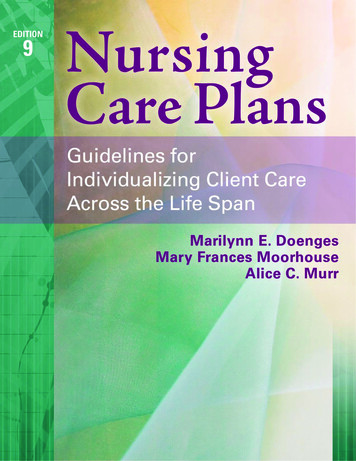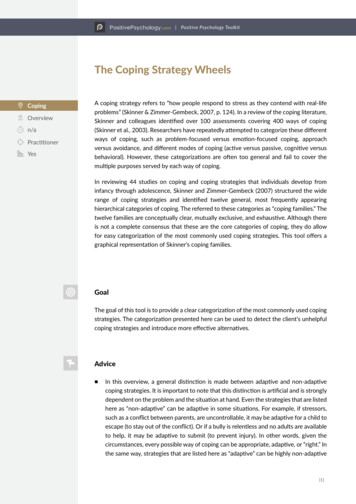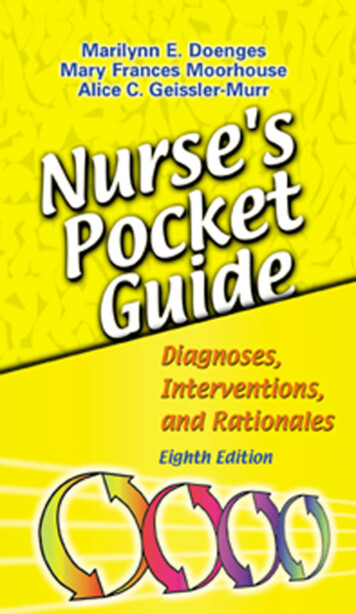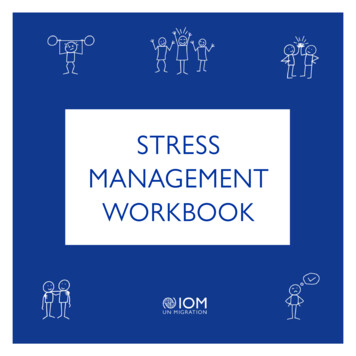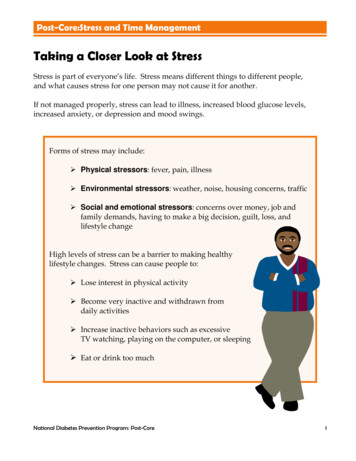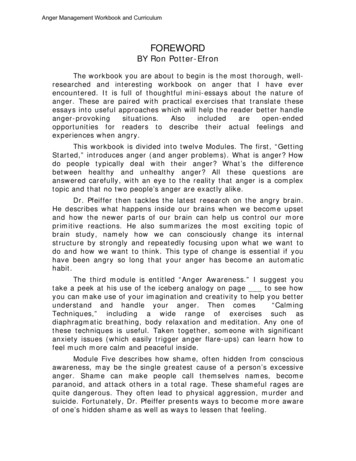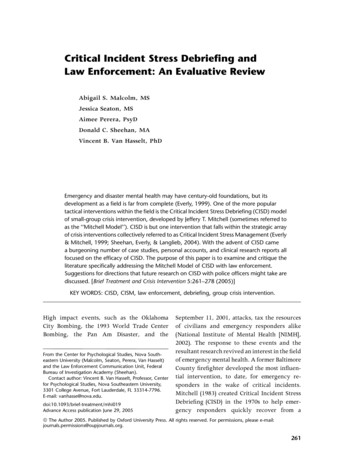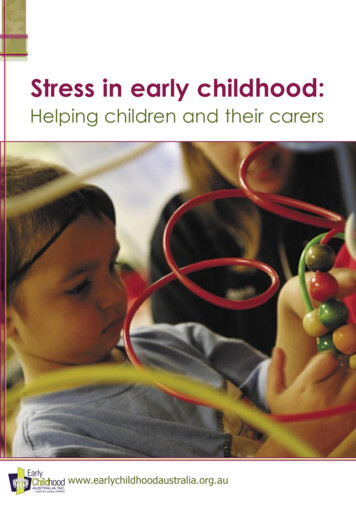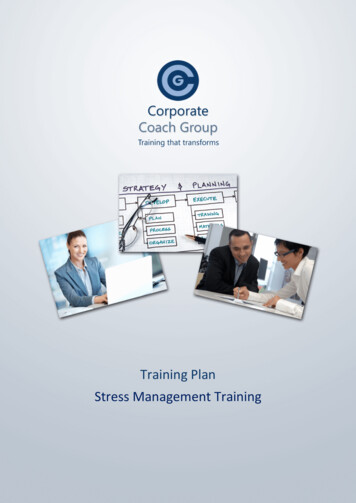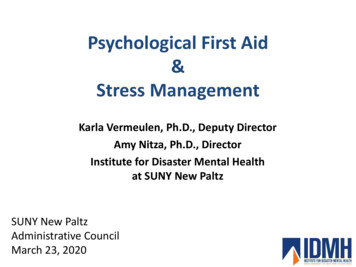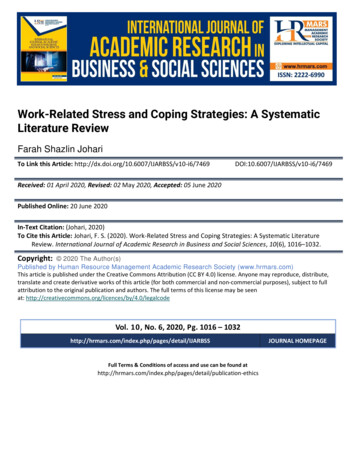
Transcription
International Journal of Academic Research in Business and Social SciencesVol. 1 0 , No. 6, June, 2020, E-ISSN: 22 2 2 -6990 2020 HRMARSWork-Related Stress and Coping Strategies: A SystematicLiterature ReviewFarah Shazlin JohariTo Link this Article: 0.6007/IJARBSS/v10-i6/7469Received: 01 April 2020, Revised: 02 May 2020, Accepted: 05 June 2020Published Online: 20 June 2020In-Text Citation: (Johari, 2020)To Cite this Article: Johari, F. S. (2020). Work-Related Stress and Coping Strategies: A Systematic LiteratureReview. International Journal of Academic Research in Business and Social Sciences, 10(6), 1016–1032.Copyright: 2020 The Author(s)Published by Human Resource Management Academic Research Society (www.hrmars.com)This article is published under the Creative Commons Attribution (CC BY 4.0) license. Anyone may reproduce, distribute,translate and create derivative works of this article (for both commercial and non-commercial purposes), subject to fullattribution to the original publication and authors. The full terms of this license may be seenat: deVol. 10, No. 6, 2020, Pg. 1016 – SSFull Terms & Conditions of access and use can be found tion-ethicsJOURNAL HOMEPAGE
International Journal of Academic Research in Business and Social SciencesVol. 1 0 , No. 6, June, 2020, E-ISSN: 22 2 2 -6990 2020 HRMARSWork-Related Stress and Coping Strategies: ASystematic Literature ReviewFarah Shazlin JohariFaculty of Business and Management, Universiti Teknologi MARAAbstractWhile the issue of work-related stress has gained increasing attention as an important constructin Western literature, coping strategies concurrently have never been comprehensively reviewedin Asian tradition. The purposes of this review are to investigate work-related stressors acrossoccupations and coping strategies used by these various occupations in reduction the stressfulenvironment. The reviewed articles were obtained from three main databases; Web of Science,Scopus and Medline. Keywords including “stress”, “work-related stress”, “work stress”,“occupational stress”, coping strategies”, “coping skills”, “coping”, and “coping mechanisms”were resulted from 14 articles that met the specified criteria. Main stressors identified in thisreview including workload, role ambiguity, responsibility, lack of job control, poor physicalenvironment, conflict, interpersonal relationship and management. While, common copingstrategies were utilized by employees were problem-focused coping, emotion-focused copingand coping resources. The present evidence is limited, and numerous research is needed onstress and coping strategies in the future to broaden its impact on work and health-relatedoutcomes.Keywords: Work-Related Stress, Stressor, Coping Strategies, Asian, Systematic LiteratureReview.IntroductionFor several decades, a plethora of stress studies have been dominating in the Western tradition.But, to date, the unresolved work-related stress is remaining debatable in literature. Somescholars claim terms and definitions of stress, occupational stress, work-related stress and jobstress are conceptualized differently, but they are grounded in the same meaning (Larson, 2004;Reddy & Poornima, 2012; Teixeira, 2014). Accordingly, the definition of work-related stress wasfirst defined by World Health Organization (WHO) as an employee’s reaction whenever they arechallenged by assigned job responsibilities that do not correspond to their knowledge, skills andabilities (WHO, 1948). In more contemporary perspective, the National Institute for OccupationalSafety and Health (2014) also acknowledges that work-related stress refers to the harmfulphysical and emotional reactions that often occur when job demands are not in line with anemployee’s capabilities, resources or needs. In this sense, work-related stress is important
International Journal of Academic Research in Business and Social SciencesVol. 1 0 , No. 6, June, 2020, E-ISSN: 22 2 2 -6990 2020 HRMARSbecause it significantly affects both employees and organizations in negative ways (Bahari et al.,2016).The effect of work-related stress is influenced by the negative perceptions of the nature ofstressors (Tuckey et al., 2015). Due to greater demands in today’s competitive workforce, workrelated stressors are unique to numerous occupations. Working in different environments cancause similar occupations to be affected by various work-related stressors such as heavyworkload, conflicts with other colleagues, lack of job control, job insecurity, lack of reward, poorworking environment and management support (Kamarulzaman et al., 2017; Yim et al., 2018;Yang et al., 2017; Park & Kim, 2013; Ren et al., 2018). Thus, neglecting these work-related stressissues can result in low job satisfaction, psychological stress, poor mental and physical well-being,high absenteeism, rates of change and intentions to quit, accidents and errors, and burnout. Allof these, will consequently, impact on the overall functioning and profitability of the organization(Sackey and Sanda, 2009).Even though work-related stress cannot be eliminated from everyday life, appropriate ways ofcoping with stress can be practiced in order to reduce it. Through efficient coping mechanismwith work-related stress, it does not only improve employee’s quality of life, but also decreasesthe cost of health care and productivity of the organization (EU-OSHA, 2012). In fact, bydefinition, coping refers to an individual’s constantly changing cognitive and behavioural effortsin managing his or her external and internal stimuli that are perceived to be above his or herresources (Lazarus & Folkman, 1984; Folkman et al., 1986). According to Lazarus and Folkman(1987), coping strategies are classified into two dimensions, namely problem-focused andemotion-focused coping. On the one hand, if individuals are capable of taking responsible actionsin changing the environment in the future, such as controlling the stressful environment, then itis advisable to use problem-focused coping. On the other hand, it is best to use emotion-focusedintervention where emotions can respond better in reducing the emotional discomfort ofindividuals in a stressful environment (Lazarus & Folkman, 1984).In addition to problem-focused and emotion-focused coping, other scholars suggest a diverserange of coping strategies including active coping, planning, suppressing competing activities,seeking instrumental support, seeking social support, positive framing, acceptance, denial,seeking a religious soothing, emotional ventilation, behavioural or mental disengagement(Amirkhan, 1990; Carver et al., 1989; Scheier et al., 1986). In this sense, coping strategies arenecessity when dealing with work-related stress and accompanying stressors (Labrague et al.,2016) as well as impacting better outcomes of particular studies.However, a broader perspective on this concept on stress and coping strategies has not beenfully explored in Asian tradition. To date, there is a dearth of knowledge on work-related stressand coping strategies simultaneously involving various occupations within Asian countries.Several systematic reviews of this concept have been identified merely to explore stress andcoping strategies among nurses (Labrague et al., 2016; Wazqar et al., 2017; Teixera et al., 2015;Labrague et al., 2018). Therefore, the purpose of this review was to systematically evaluate and
International Journal of Academic Research in Business and Social SciencesVol. 1 0 , No. 6, June, 2020, E-ISSN: 22 2 2 -6990 2020 HRMARSsynthesize the existing literature in (1) investigating the types of stressors across occupations;and (2) examining the pattern of coping strategies practiced among employees.MethodsDesignThis study conducted a systematic literature review by relevant criteria from the PreferredReporting Items for Systematic Reviews and Meta-Analyses (PRISMA). It consists of five subsections including search strategy, inclusion and exclusion criteria, eligibility, data abstractionand analysis.Search StrategyA systematic search strategy was implemented through three electronic databases, namely Webof Science, Scopus and Medline. The keywords in the titles and abstracts were used in the searchprocess including “stress”, “work-related stress”, “work stress”, “occupational stress”, “copingstrategies”, coping skills”, “coping”, “cope” and “coping mechanisms”. This process yielded aresult of 1113 documents from Web of Science (WOS), 2304 documents from Scopus and 2341documents from Medline databases were retrieved.Inclusion and Exclusion CriteriaThe first criterion for inclusion concerned a timeline, and a period of ten years, between the yearof 2010 to 2020 was selected. The second inclusion criterion was document types, journal(research articles) with empirical data as primary sources were selected. The third inclusion wasarticles published in the field of social science, organizational psychology, as well as business andmanagement, were selected to increase the possibility of retrieving related articles. The fourthinclusion was regarding on region, where only the Asian region was selected in this review. Thefifth was focusing on articles published in English language. The final inclusion was including theselection of samples involving employees across occupations. Meanwhile, the exclusion criteriawere systematic review, meta-analysis, chapter in book, review papers, non-research papers,non-English papers and samples other than employees as stated in Table 1. Overall, a total of5495 articles were excluded based on these criteria, as stated in Figure 1. After the identificationprocess, out of 263 documents to be screened 155 documents were retained for the next stage.EligibilityA total of 57 articles were prepared for the third stage known as the eligibility. Eligibility is aprocess that includes or excludes articles manually according to the authors’ specific criteria. Atthis stage, the titles, abstracts and the main contents of all the articles were examined thoroughlyto ensure that they fulfilled the inclusion criteria and fit to be employed in the present study toachieve the objective of the current research. Before the eligibility process was carried out, theduplicated documents were removed first. A total of 18 articles were traced as similar articleswere excluded in both databases for the next phase. Finally, a total of 57 remaining articles areready to be analyzed.
International Journal of Academic Research in Business and Social SciencesVol. 1 0 , No. 6, June, 2020, E-ISSN: 22 2 2 -6990 2020 HRMARSCriteriaTimelineDocument typesSubject areaRegionLanguageSampleTable 1. Inclusion and Exclusion CriteriaInclusionExclusionBetween 2010 to 2020 2010Journal (research articles)Systematic review, metaanalysis, chapter in book, reviewpapers, non-research papersSocial Science, OrganizationalOther than Social Science,Psychology, Business andOrganizational Psychology,ManagementBusiness and ManagementAsianOther than AsianEnglishNon-EnglishWorker, employeesStudents, patients, elderly,child, parentData Abstraction and AnalysisThe remaining articles were evaluated, reviewed and analyzed after the eligibility process. Thedata were extracted to identify relevant themes and sub-themes for the present study by readingtitles, abstracts and then throughout the full text of articles (in-depth). During the review process,answers were sought by the following: (a) the research design; (b) the type of stress; (c) the typeof coping strategies; (d) the sample selection and (e) study region. From the search describedabove, 57 articles were identified. After reading the abstracts, 20 articles were omitted becausethey were irrelevant to the research questions. These omitted articles either did not test therelationship between stress and coping strategies or examined stress and coping strategiesamong students, elderly and patients. After a detailed reading of the full texts, 14 articlesremained. The summaries of each articles included in this review were presented in Table 2 – 7.
International Journal of Academic Research in Business and Social SciencesVol. 1 0 , No. 6, June, 2020, E-ISSN: 22 2 2 -6990 2020 HRMARSRecords identifiedthrough databasesearchingWeb of Science(n 1113 )Records identifiedthrough databasesearchingScopus(n 2304 )Records identifiedthrough databasesearchingMEDLINE(n 2341 )Records excluded due to review article,books, chapter in books, non-Englishlanguage, published 2010(n 263 )Total recordsafter screened(n 155 )Duplicate recordwere removed(n 18 )Full-text articlesassessed foreligibility(n 57 )Full text articleexcluded due toirrelevant area ofinterest(n 43 )Studies includedin qualitativesynthesis(n 14 )Figure 1: Flow Diagram for the systematic literature review process
International Journal of Academic Research in Business and Social SciencesVol. 1 0 , No. 6, June, 2020, E-ISSN: 22 2 2 -6990 2020 HRMARSResultsThe results provided a comprehensive analysis of the present stress, coping strategies and majorfindings of those studies.Country Setting and Sample SelectionFourteen studies were included in the review. As shown in Table 2, most of the studies reviewedwere conducted in China (4), followed by two studies from South Korea, Malaysia and Indiarespectively. Finally, each study from Saudi Arabia, the Philippines, Pakistan and Bangladesh wereextracted.Table 2: CountryCountryChinaSouth KoreaMalaysiaIndiaSaudi eanwhile, studies on stress and coping strategies have recruited samples selection acrossvarious sectors such as nurses, teachers, police officers, bank employees, construction workersand others as stated in details in Table 3.Table 3: SampleSampleNursesTeachersPolice OfficersPetroleum Industry WorkersHotel EmployeesIT EmployeesSteel Construction WorkersCable Manufacturing WorkersRescue WorkersBank EmployeesAcademic and Non-Academic StaffTotal2112211111114Research DesignIn relations to the research design in table 4, most of the studies used a cross-sectional design(12 articles), while only two studies were used longitudinal research design.
International Journal of Academic Research in Business and Social SciencesVol. 1 0 , No. 6, June, 2020, E-ISSN: 22 2 2 -6990 2020 HRMARSTable 4: Research DesignResearch DesignCross-sectional designLongitudinal design122Total14Work-related StressThe review resulted in identifying two types of stress, divided into two main sub-themes beingidentified, namely tasks and organizational stressors. As shown in table 5, most of the studies (7articles) stipulated that workload was major contributor to tasks stressors across occupations.Other types of stress widely discussed in reviewed studies are role ambiguity (4 articles),responsibility (4 articles), lack of job control (4 articles), working or physical environment (4articles), participation (3 articles), conflict (3 articles) and interpersonal relationship (3 articles).Other types of stress are less discussed in these reviewed studies, as stated in table 5. Meanwhile,two articles not stated the types of work-related stress in the studies.As shown in Table 6, most studies (4 articles) stipulated that management is a major contributorto organizational stressors. Followed by organizational system or technology, organizationalproblem, the closeness of cooperation, work interruption and accident risk with two articlesrespectively. Meanwhile, each studies for death and dying, occupational climate, political andunprofitability.Coping StrategiesAccording to Table 7, at least eight sub-theme of coping strategies have been identified in thisreview including problem-focused coping, emotion-focused coping, avoidant-coping, positivecoping, negative coping, coping resources, self-care coping, pro-social coping behaviour andother independent coping. As listed in the table, most studies implemented three major copingstrategies such as problem-focused coping, emotion-focused coping and coping resources. Inproblem-focused coping, most studies implemented problem-solving and seeking social supportapproach (4 articles). Meanwhile, most studies used the avoidance approach in emotion-focusedcoping (4 articles). Finally, three studies implemented the same coping resources includingrecreation, self-care, social support and rational coping approach. Meanwhile, other copingstrategies were only practiced by one or two times by several studies. However, a studyconducted by Mendoza (2019) stated the similar type of coping strategies related to stressorsused in the respective study.
International Journal of Academic Research in Business and Social SciencesVol. 1 0 , No. 6, June, 2020, E-ISSN: 22 2 2 -6990 2020 HRMARSNaholiet al.2015WorkloadJob demandRole ambiguityRole insufficiencyRole boundaryResponsibilityJob decision latitudeMultitaskLack of job controlLack of supportLack of iesLow statusJob ryPersonalInadequatepreparationMendo-za2019Ryuet al.2020 Table 5: Job StressorsLi et Xiao et Huangal.al.et al.201720172018 Kosalai&Mahes-wari2018 Widajati2018Rasdi&Fadzil2018Lianet al.2017Ukil &Ullah2016 Mukosoluet al.2015
International Journal of Academic Research in Business and Social SciencesVol. 1 0 , No. 6, June, 2020, E-ISSN: 22 2 2 -6990 2020 HRMARSUncertainty oftreatmentPatient mentAnxious worryingAnxietyDepression Naholiet al.2015Death & dyingOrg. system /technologyOccupational climateManagementOrganizationalproblemCloseness ofcooperationAccident riskWork interruptionPoliticalUnprofitability Mendoza2019Table 6: Organizational StressorsRyu etLi et Xiao et Huang Kosalaal.al.al.et al.i&2020201720172018 Maheswari2018Widajati2018Rasdi&Fadzil2018Lian etal.2017Ukil &Ullah2016 Mukosolu etal.2015
International Journal of Academic Research in Business and Social SciencesVol. 1 0 , No. 6, June, 2020, E-ISSN: 22 2 2 -6990 2020 HRMARSNaholiet al.2015Problem-focused copingProblem solvingActive coping on-focused eligionAvoidanceFocus/venting haviouraldisengagementDenialMental disengagementSelf-distractionRyuet al.2020 Li etal.2017Table 7: Coping strategiesXiaoHuKosa- Wida- Rasdiet al.anglai &jati&Fad2017et al. Mahe 2018zilswari20182018 Jamal2017Lianet al.2017Ukil & MukoUllahsolu2016 et al.2015 Choiet al.2019
International Journal of Academic Research in Business and Social SciencesVol. 1 0 , No. 6, June, 2020, E-ISSN: 22 2 2 -6990 2020 HRMARSSelf-blamePositive copingSupport from family &friendsUtilizing others’ way ofdealing with problemsNegative copingProcrastinatingRelying on othersTrying to forget abouteverythingSelf-care copingSleepingDrinking coffeePers. perspective value of workParticipate in activities& eatingCoping resourcesRecreationself-careSocial supportRational copingOther independent copingAssistance pursuit styleHopeful thinking styleArranging toursAwardsAppreciationMonetary motivations
International Journal of Academic Research in Business and Social SciencesVol. 1 0 , No. 6, June, 2020, E-ISSN: 22 2 2 -6990 2020 HRMARSDiscussionsThis review identified the types of work-related stress, its stressors and coping strategies used byvarious occupations across Asia. As stipulated in the review results, most studies conducted in Chinainvolved various occupations including nurses, hotel employees and petroleum industry workers (Liet al., 2017; Xiao et al., 2017; Huang et al., 2018; Lian et al., 2017). While other countries were utilizeddifferent samples such as teachers, police officers, IT employees, bankers, rescue workers, academicand non-academic staff, construction and manufacturing workers (Naholi et al., 2015; Mendoza,2019; Ryu et al., 2020; Kosalai & Maheswari, 2018; Widajati, 2018; Rasdi & Fadzil, 2018; Jamal, 2017;Ukil and Ullah, 2016; Mukosolu et al., 2015; Choi et al., 2019). In this sense, the utilized sample of thisreview, limiting the generalizability of findings and additional inclusion of other occupations fromdifferent settings may require providing more generalizable findings.Concerning the research design, the researcher found that most studies were cross-sectionaldominated by self-reported data (Naholi et al., 2015; Mendoza, 2019; Ryu et al., 2020; Li et al., 2017;Kosalai & Maheswari, 2018; Huang et al., 2018; Widajati, 2018; Rasdi & Fadzil, 2018; Jamal, 2017; Ukiland Ullah, 2016; Mukosolu et al., 2015; Choi et al., 2019). Only two related studies used longitudinalresearch design in this review (Lian et al., 2017; Xiao et al., 2017). This may be because this design ismore convenient and easier to be conducted at one time as compared to longitudinal design.However, this study may involve common method bias in considering the nature of stressexperiences. In fact, Lazarus and Folkman (1987) argue that stress may change across time and sincethey were asked to recall their previous stressful experiences, they may not be able to recall some ofthese stressful experiences. The use of a longitudinal study may be necessary to detect changes forstress and coping abilities across a few months.The synthesis of this review was difficult to quantify because of the great number of stressors, andcoping strategies were identified, thus creating a variation on the following themes. Although, somescholars claimed that work-related stressors are identified in three main categories, including the job,the team and the organizational level (Salin & Hoel, 2011; Samnani & Singh, 2012), this review onlyfocused on two sub-themes. The current review revealed that the main job stressors acrossoccupations generally originated from heavy workload, role ambiguity, responsibility, lack of jobcontrol and poor physical environment (Naholi et al., 2015; Li et al., 2017; Xiao et al., 2017; Kosalai &Maheswari, 2018; Rasdi & Fadzil, 2018; Lian et al., 2017; Ukil & Ullah, 2016). Meanwhile,management issues were a major contributor to organizational stressors across occupations(Mendoza, 2019; Li et al., 2017; Kosalai & Maheswari, 2018; Widajati, 2018). In line with previousreviews, the workload is considered as one the most often-cited job stressors across occupations(Van den Brande et al., 2016; Wazqar et al., 2017).Several coping strategies were mentioned in this review to address work-related stress across variousoccupations. Most studies implemented three major coping strategies, problem-focused coping (Ryuet al., 2020; Huang et al., 2018; Widajati 2018; Rasdi & Fadzil, 2018; Jamal, 2017; Mukosolu et al.,2015; Choi et al., 2019), emotion-focused coping (Ryu et al., 2020; Huang et al., 2018; Rasdi & Fadzil,2018; Jamal, 2017; Mukosolu et al., 2015; Choi et al., 2019) and coping resources (Xiao et al., 2017;Lian et al., 2017; Ukil & Ullah, 2016). As listed, similar studies were identified the used of problemfocused and emotion-focused coping simultaneously. These coping strategies are in line with popular1028
International Journal of Academic Research in Business and Social SciencesVol. 1 0 , No. 6, June, 2020, E-ISSN: 22 2 2 -6990 2020 HRMARSstrategies mainly proposed by Lazarus and Folkman (1987), in which employees prefer to adjust theiractivities in managing problems within the environment and take action to change the individualattitude towards emotions (Lazarus, 2000; Lazarus and Folkman, 1987). Besides, in line with theprevious review conducted by Vand den Brande et al. (2016), coping resources are also included aspart of coping strategies, in which it impacts the tendency to conduct a certain coping strategy(Lazarus & Folkman, 1984; Jerusalem, 1993).Limitations and RecommendationsThe divergence of the reviewed studies in terms of sample characteristics, instruments, datacollection tools, and operational definitions of the study variables may have led to difficulties inattempting to generalize the results. Also, there is limited evidence in using a longitudinal design tomeasure this phenomenon, and no further discussion involving common method bias for the crosssectional design for this review studies. A future recommendation should include the discussion onseveral methodological limitations that were not adequately investigated in this review, such ascombining qualitative, mixed-method, experimental research designs. Besides, the range of yearsshould be lengthier than ten years and the impact of stress and coping strategies on work and healthrelated outcomes.ConclusionThis review provides a systematic way of understanding the relationship between work-related stressand coping strategies, specifically across different sources of data, different research designs andanalysis. This systematic review hopefully could facilitate future researchers in providing betterunderstandings on work-related stressors and make more sense to the relevance coping services tobe implemented in reducing these stressors. The review offers several recommendations for futurestudies such as involving more samples across occupations within the lengthier times. It is alsosuggested to discussing more methodological matters in a future review including longitudinal,qualitative, mixed-method, experimental research designs. Finally, more research should beconducted in the context of stress and coping strategies, given the determination in addressing workand health-related outcomes of employees.Corresponding AuthorFarah Shazlin Johari, Faculty of Business and Management,Universiti Teknologi MARA, MalaysiaEmail: farahshazlin@uitm.edu.myReferencesBahari, F., Tan, A. L., & Wider, W. (2016). The Effect of Occupational Stress on Teachers’Psychological Well-Being: Social Support as Moderator. Australian Journal of Basic andApplied Sciences, 10 (4), 56-65.Carver, C., Scheier, M., & Weintraub, J. (1989). Assessing coping strategies: A theoretically basedapproach. Journal of Personality and Social Psychology, 56(2), 267–283.1029
International Journal of Academic Research in Business and Social SciencesVol. 1 0 , No. 6, June, 2020, E-ISSN: 22 2 2 -6990 2020 HRMARSChoi, H.-M., Mohammad, A. A. A., & Kim, W. G. (2019). Understanding hotel frontline employees’emotional intelligence, emotional labor, job stress, coping strategies and burnout.International Journal of Hospitality Management, 82, 199-208.EU-OSHA. (2012). Management of Psychosocial Risks at Work: An Analysis of The Finding of TheEuropean Survey of Enterprises on New and Emerging Risks (ESENER). Luxembourg:Publications Office of the European Union.Folkman, S., Lazarus, R. S., Dunkel-Scetter, C., DeLongis, A., & Gruen, R. J. (1986). Dynamics of astressful cognitive appraisal, coping, and encounter outcomes. Journal of Personality andSocial Psychology, 50(5), 992-1003.Huang, S. S., Van der Veen, R., & Song, Z. (2018): The impact of coping strategies on occupationalstress and turnover intentions among hotel employees. Journal of Hospitality Marketing &Management, 1-20.Jamal, Y. (2017). Coping strategies as a mediator of hardiness and stress among rescue workers.Studies on Ethno-Medicine, 11(3), 201-208.Jerusalem. (1993). Personal resources, environmental constraints, and adaptational processes: Thepredictive power of a theoretical stress model. Personality and Individual Differences, 14(1),15–24.Kamarulzaman, K. A., Zulkifly S. S., & Hasan N. H. (2017). Occupational stress among a cancerhospital nurses. Human Factors and Ergonomics Journal, 2(3), 12 – 20.Khan, J. H. A. (1990). A factor analytically derived measure of coping: The coping strategy indicator.Journal of Personality and Social Psychology, 59(5), 1066–1074.Kosalai, S., & Maheswari, G. S. (2018). Stress level and coping strategies of IT sectors. Indian Journalof Public Health Research and Development, 9(11), 71-76.Labrague, L. J., McEnroe-Petitte, D. M., De Los Santos, J. A. A., & Edet, O. B. (2018). Examining stressperceptions and coping strategies among Saudi nursing students: A systematic review.Nurse Education Today, 65, 192-200.Labrague, L. J., McEnroe-Petitte, D. M., Gloe, D., Thomas, L., Papathanasiou, I. V., & Tsaras, K.(2016): A literature review on stress and coping strategies in nursing students. Journal ofMental Health, 1-10.Larson, L. L. (2004). Internal auditors and job stress. Managerial Auditing Journal, 19(9), 1119-1130.Lazarus, R. S. (2000). Toward better research on stress and coping. American Journal of Psychology,55(6), 665–673.Lazarus, R. S., & Folkman, S. (1987). Transactional theory and research on emotions and coping.European Journal of Person Centered Healthcare, 1, 141–69.Lazarus, R. S., & Folkman, S. (1984). Stress, appraisal, and coping. New York, NY: Springer.Lian, Y., Gu, Y., Han, R., Jiang, Y., Guan, S., Xiao, J. & Liu, J. (2016). Effect of changing work stressorsand coping resources on psychological distress. Journal of Occupational and EnvironmentalMedicine, 58(7), 256-263.Li, L., Ai, H., Gao, L., Zhou, H., Liu, X., Zhang, Z., Sun, T., & Fan, L. (2017). Moderating effects ofcoping on work stress and job performance for nurses in tertiary hospitals: a cross-sectionalsurvey in China. BMC Health Services Research, 17, 401.Mendoza, R. D. Jr. (2019). Verbal English fluency, workplace stress and coping mechanism ofsecondary school faculty in Sulu. The Asian EFL Journal, 21(2), 78-100.1030
International Journal of Academic Research in Business and Social SciencesVol. 1 0 , No. 6, June, 2020, E-ISSN: 22 2 2 -6990 2020 HRMARSMukosolu, O., I
Work-Related Stress, Stressor, Coping Strategies, Asian, Systematic Literature Review. Introduction . For several decades, a plethora of stress studies have been dominating in the Western tradition. But, to date, the unresolved work-
